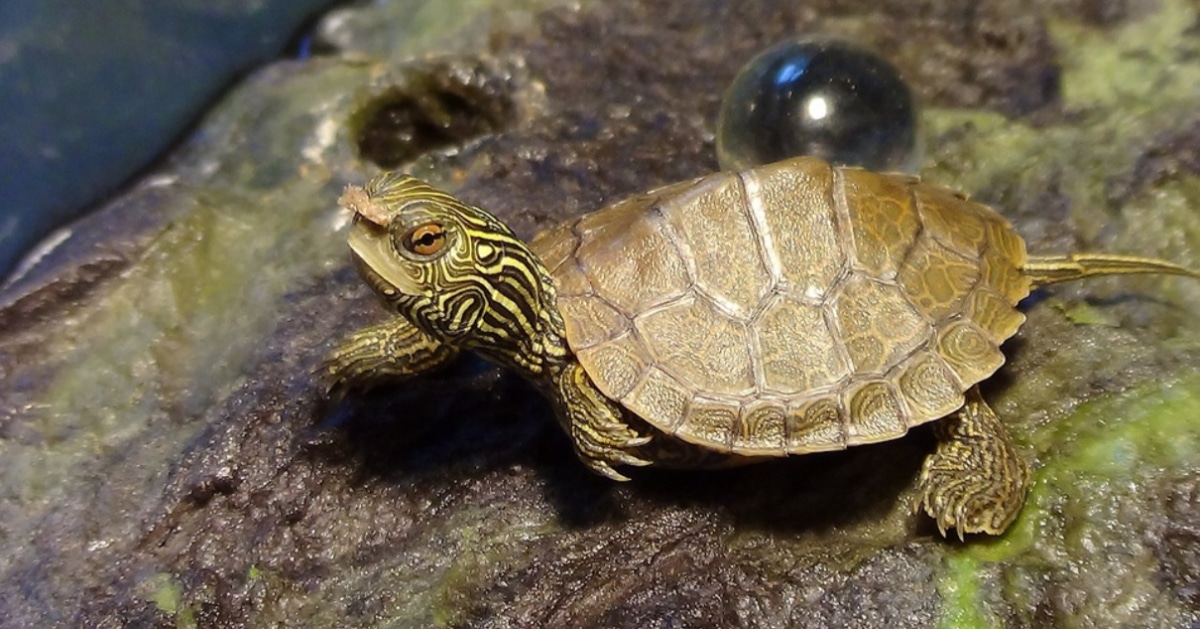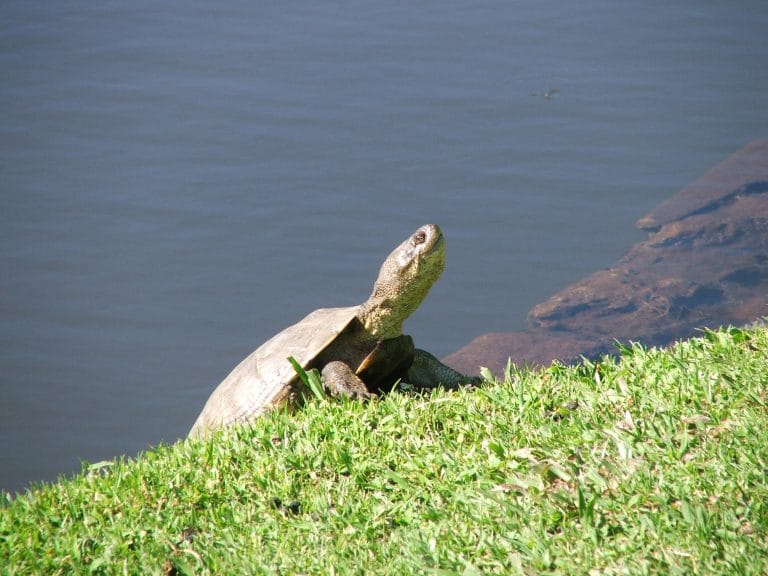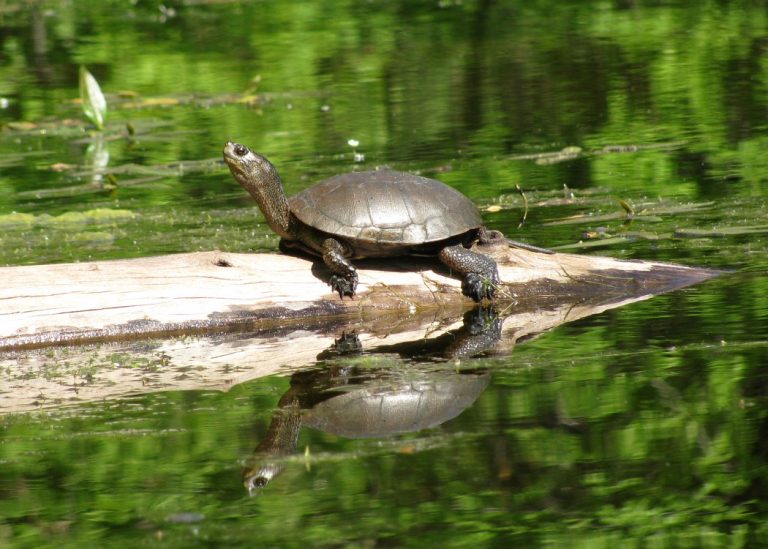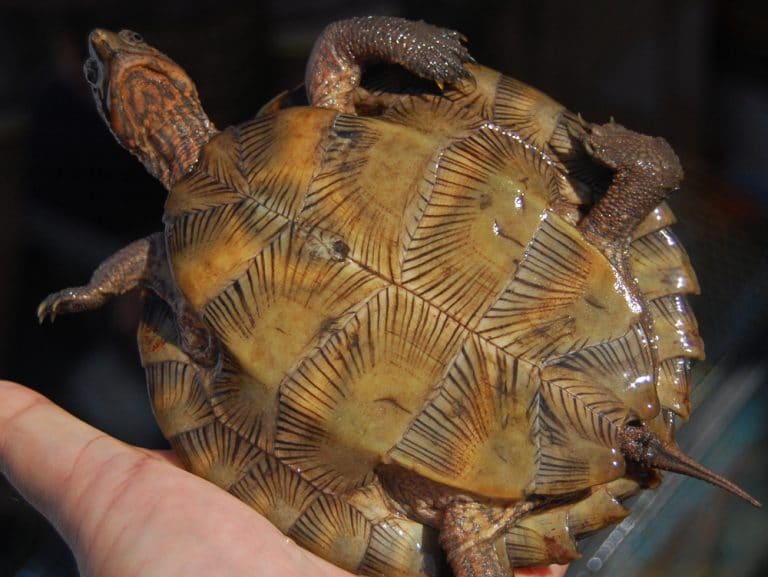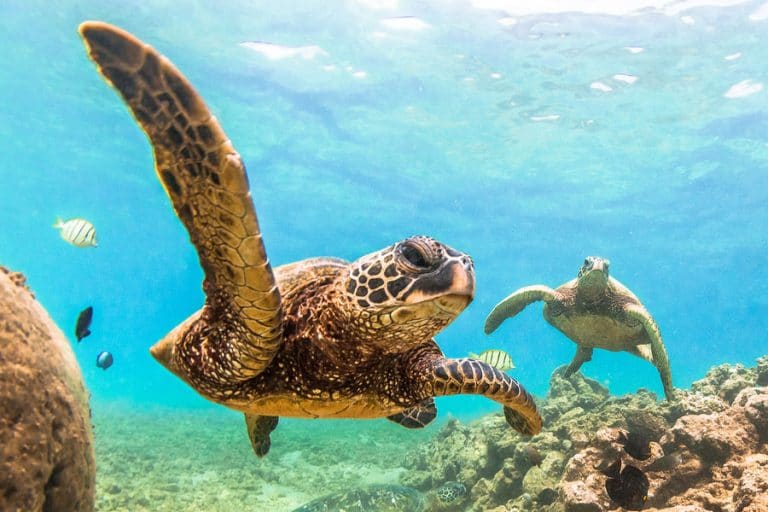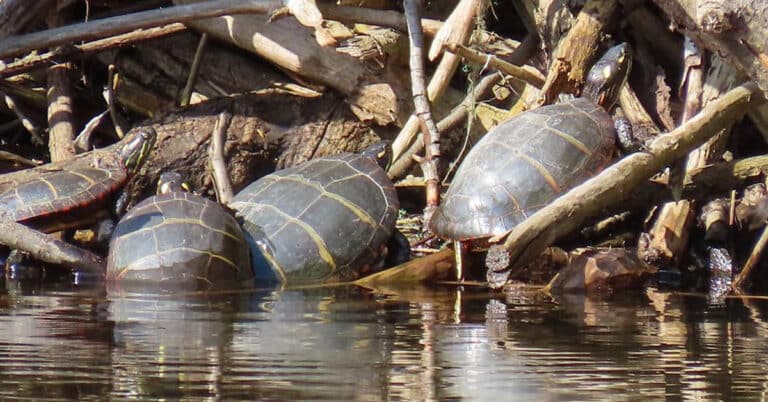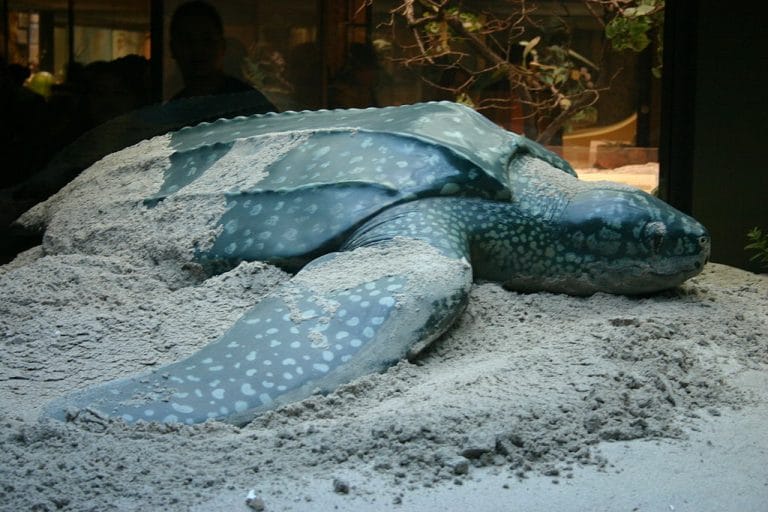Smallest Aquatic Turtles In The World
Turtles are some of the world’s oldest creatures, first showing up in our fossil records around 230 million years ago, though many scientists believe they could have existed long before that. In fact, some believe they date as far back as 300 million years during the Carboniferous period.
Turtles were much, much different back then.
Though they had their trademark roundish builds, their limbs, including their necks, were much longer than they are today, and they didn’t possess that shell they’re now known for.
Like most animals of their time period, turtles originated in water.
Today’s sea turtles for instance have gone unchanged for the last 110 million years.
There are 356 recognized species of turtles that still exist in the world today; seven of them are sea turtles, 25 belong to the softshell turtle family, 49 of which are tortoises, and many, many more.
We’ll only be mentioning two of those species in this piece however, as the vast majority of the species and subspecies of those genus are quite large and don’t even come close to the smallest aquatic turtles.
Instead, as the title suggests, we’ll be talking about the smallest aquatic turtles in the world today.
Did you know?: Most people often confuse tortoises with turtles
It’s true, and it’s easy to see why given their appearance and body structure.
Firstly, we’ll begin by saying tortoises are a type of turtle, but not all turtles are tortoises. Confusing? Read this piece on the difference between turtles and tortoises for a better understanding.
Before we get into our list of the smallest aquatic turtles in the world, it’s important to know that in a turtles world, males are almost always smaller than females (and that is true to all the mentions on this list).
This is because female turtles, as well as most animals that reproduce by laying eggs, need that extra size and girth to carry eggs inside her body prior to laying them.
Therefore, the bigger end of the size spectrum will be the size of females in that particular species, with the smaller end being males.
Now that you know the difference in size between sexes, let’s get into out list of the smallest aquatic turtles in the world.
For this piece, we’ll be breaking down 11 species of turtles through 38 sub-species, first beginning with mud turtles:
Mud Turtles
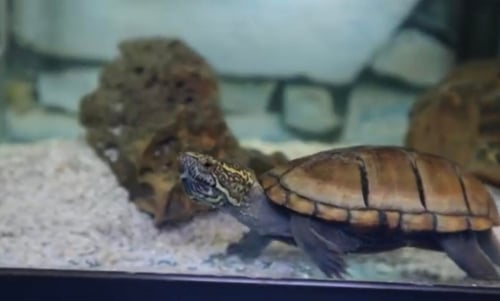
Mud turtles can be found throughout the Americas in lakes, rivers, and swamps from New England to Northern Argentina, living in the fresh and brackish water systems of these areas.
Mud turtles are opportunistic omnivores that feed mainly on crustaceans such as crayfish and mollusks, aquatic insects, and seeds.
Eastern Mud Turtle (pictured above)
- Size: 3-to-5 inches
- Lifespan: 20 years
- Range: Long Island to Southern Florida, west to Central Texas, up the Mississippi Valley to southern Illinois and southwestern Indiana
Scorpion Mud Turtle
- Size: 3.6-to-10.6 inches
- Lifespan: 45 years
- Range: Central America and South America
White-Lipped Mud Turtle
- Size: 4-to-7 inches
- Lifespan: 30-to-50 years
- Range: Mexico, Belize, Costa Rica, Guatemala, Honduras, Nicaragua, Panama, Colombia, Ecuador, and Peru
Tabasco Mud Turtle
- Size: 4-to-5 inches
- Lifespan: Up to 45 years
- Range: Central Veracruz across the Tabasco lowlands of Mexico to northern Guatemala and Belize
Yellow Mud Turtle
- Size: 4-to-5 inches, rarely exceeds 6.5 inches
- Lifespan: Over 40 years
- Range: New Mexico, Oklahoma, Nebraska, Kansas, Arizona, Colorado, and Utah
Central American Mud Turtle
- Size: 4-to-5 inches
- Lifespan: Unknown
- Range: Costa Rica, Nicaragua, and Panama
Striped Mud Turtle
- Size: 4-to-5 inches
- Lifespan: Up to 50 years
- Range: Throughout Florida and the Florida Keys
Sonoran Mud Turtle
- Size: Up to 7 inches
- Lifespan: 8-to-12 years
- Range: Southeastern and central Arizona, New Mexico, northern Sonora, and Chihuahua, Mexico
Oaxaca Mud Turtle
- Size: Up to 6 inches
- Lifespan: 20-to-40 years
- Range: Guerrero and Oaxaca
Dunn’s Mud Turtle
- Size: Up to 7 inches
- Lifespan: Unknown
- Range: Streams and marshes of Rio Baudo, Rio Docampado, Rio San Juan, and Rio Atrato drainage basins of the Departamento del Choco in western Colombia
Alamos Mud Turtle
- Size: 3.5-to-4.7 inches, rarely exceeds 5 inches
- Lifespan: Unknown
- Range: Mexico in states such as Sinaloa and Sonora
Painted Turtles
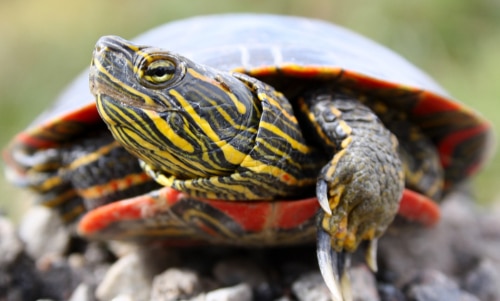
The most widely distributed turtles in North America, painted turtles range the entire east-to-west coasts of the United States, living as far north as Southern Canada and as far south as the Gulf of Mexico.
Painted turtles live in ponds, lakes, freshwater marshes, and other slow-moving water systems throughout the United States, and have a diet consisting of a variety of plants, fish, crustaceans, aquatic insects, and carrion.
Painted turtles are known to be great pets, and being some of the smallest aquatic turtles in the world means they’re one of the easier breeds to care for.
Western Painted Turtle
- Size: 6-to-10 inches
- Lifespan: 15-to-30 years, sometimes exceeding 50 years
- Range: South-central Canada, from Washington to Wisconsin, as far south as Missouri
Southern Painted Turtle
- Size: 4-to-6 inches
- Lifespan: 15-to-30 years, sometimes exceeding 50 years
- Range: Southern Illinois and Missouri, Mississippi to Louisiana
Eastern Painted Turtle (pictured above)
- Size: 4-to-7 inches
- Lifespan: 15-to-30 years, sometimes exceeding 50 years
- Range: Maine to Georgia
Midland Painted Turtle
- Size: 4-to-8 inches, rarely exceeds 9 inches
- Lifespan: 15-to-30 years, sometimes exceeding 50 years
- Range: Quebec and southern Ontario to Tennessee, to northern Georgia and Alabama
Musk Turtles
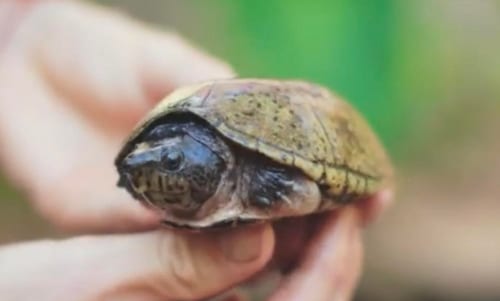
Like painted turtles, musk turtles are found mainly in North America, though more so through the eastern and south eastern stretches with the Mexican giant musk turtle and narrow-bridged musk turtles being the exception.
Musk turtles have an omnivorous diet consisting of seeds, insects, snails, tadpoles, algae, and occasionally carrion.
The common musk turtle, or also known as the stinkpot turtle, is widely considered the smallest aquatic turtle in the entire world.
Razorback Musk Turtle
- Size: 5-to-6 inches
- Lifespan: 20-to-40 years
- Range: South-central Mississippi to the Gulf of Mexico, Oklahoma to Arkansas to Texas
Flattened Musk Turtle
- Size: 3-to-4.7 inches
- Lifespan: 40-to-60 years
- Range: Only known to live in Alabama
Common Musk Turtle
- Size: 2-to-5 inches
- Lifespan: 40-to-60 years
- Range: Great Lakes region, throughout Illinois to western Kansas and Oklahoma, as far west as Texas
Loggerhead Musk Turtle (pictured above)
- Size: 3-to-5 inches
- Lifespan: 20-to-24 years
- Range: Central Florida, as far north as Virginia, as far west as Louisiana
Intermediate Musk Turtle
- Size: 3-to-4 inches
- Lifespan: 15-to-60 years
- Range: Choctawhatchee and Escambia River basins in Alabama and Florida
Mexican Giant Musk Turtle
- Size: Up to 15 inches
- Lifespan: 20-to-30 years
- Range: Belize, northeastern Guatemala, western Honduras, and Mexico
Narrow-Bridged Musk Turtle
- Size: 4-to-6.5 inches
- Lifespan: 16 years
- Range: Central America and Mexico
Wood Turtles
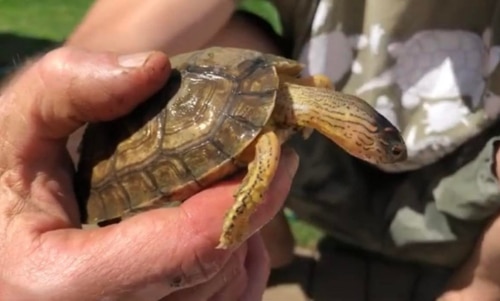
Wood turtles are also one of the smallest aquatic turtles out there and are found throughout the north eastern United States into parts of Canada, inhabiting large rivers and streams, riparian forests, wetlands, and hayfields in those areas.
Perhaps the most opportunistic eaters on this list, wood turtles are not at all picky regarding what they can fit into their mouths, feeding on a wide variety of things such as slugs, worms, tadpoles, insects, algae, wild fruit, leaves, grass, moss, and carrion.
North American Wood Turtle
- Size: 5-to-8 inches, biggest ever recorded was 9.8 inches
- Lifespan: 40-to-60 years
- Range: New England states, Nova Scotia, as far west as Michigan, north to Indiana and Minnesota, and as far south as Virginia
Central American Wood Turtle
- Size: 7-to-10 inches
- Lifespan: 25-to-35 years
- Range: Mexico to northern Ecuador and northern Brazil
Furrowed Wood Turtle (pictured above)
- Size: 4-to-6 inches
- Lifespan: 19 years
- Range: Marshy woodlands and savannahs of Mexico, Belize, and Guatemala
Black Wood Turtle
- Size: Up to 14 inches
- Lifespan: 20-to-30 years
- Range: Deep bodies of freshwater including rivers, streams, swamps, marshes, ponds, and lakes throughout Central America in places such as Panama, Costa Rica, Honduras, Nicaragua, and the Coco River
Spot-legged wood turtle (painted wood turtle)
- Size: 5-to-7 inches
- Lifespan: 20 years
- Range: Brazil, French Guiana, Guyana, Suriname, Trinidad, Tobago, and Venezuela
Large-Nosed Wood Turtle
- Size: 6-to-10 inches
- Lifespan: 25-to-30 years
- Range: Northwestern Colombia to northwestern Ecuador
Box Turtles
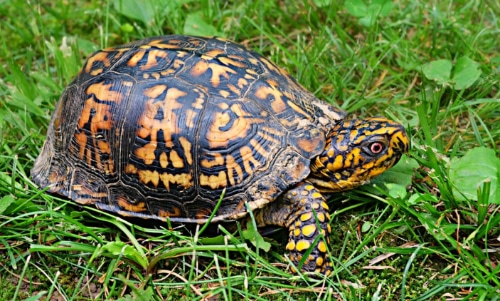
Box turtles, like the three previously mentioned species and sub-species, inhabit much of the eastern United States and are also one of the smallest aquatic turtles.
Box turtles are unlike most other turtles, as they live a much more tortoise-like, terrestrial life. They’re shaped much like a tortoise with their shell having a more domed appearance, and they don’t spend as much time in the water as most other turtles, making them a more semi-aquatic species.
But, don’t let that fool you; they are true turtles, and as such they are strong swimmers. So, therefore, they make our smallest aquatic turtles in the world list.
They inhabit a variety of areas throughout woodlands, field edges, thickets, marshes, stream banks, and bogs of the eastern US, feeding on a balanced diet of flowers, roots, fungi, berries and other fruits, snails, slugs, insects, fish, and frogs.
Florida Box Turtle
- Size: 4-to-6 inches
- Lifespan: 25-to-50 years, sometimes over 100 years
- Range: Georgia and Florida
Eastern Box Turtle (pictured above)
- Size: 4-to-6 inches, biggest ever measured nearly 8 inches
- Lifespan: 50 years to over 100 years
- Range: Southeastern Maine to southeastern New York, as far west as Illinois, as far south as Florida
Three-Toed Box Turtle
- Size: 3.5-to-6.5 inches
- Lifespan: 50-to-80 years, sometimes over 100 years
- Range: Missouri and Oklahoma to Alabama and west into Texas
Gulf Coast Box Turtle
- Size: 5-to-7 inches, largest ever recorded measured 8.5 inches
- Lifespan: 40-to-100 years, oldest ever recorded was 138 years old
- Range: Along the Gulf of Mexico, from Louisiana to Florida
Bog Turtle
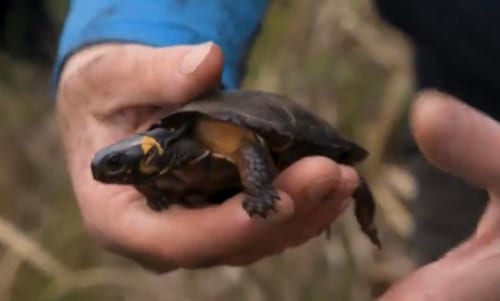
This species naturally occurs strictly in the eastern United States through a small 250 mile range from Virginia and West Virginia.
It’s almost sad the bog turtles‘ range is so small, they’re one of the most beautiful turtles on this entire list.
Bog turtles feed on seeds, berries, insects, slugs, worms, crayfish, frogs, snakes, snails, and carrion.
- Size: 3.5-to-4.5 inches
- Lifespan: Up to over 60 years
- Range: Virginia and West Virginia
Spotted Turtle
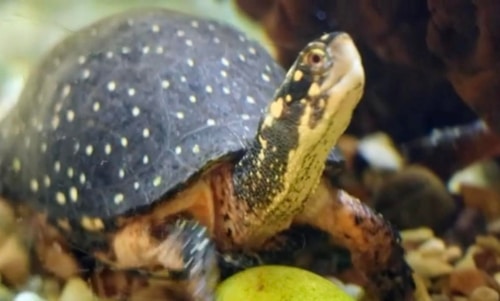
What can we say, North America has many of the smallest aquatic turtles in the world.
Spotted turtles live in marshy meadows, bogs, swamps, ponds, and other small bodies of still water, even in ditches.
Their diets consist of aquatic plants, small fish, snails, worms, slugs, spiders, tadpoles, and small crustaceans.
- Size: 3.5-to-4.5 inches, biggest ever recorded measured 5 inches
- Lifespan: 65-to-110 years
- Range: Eastern Great Lake region, as far north as Ontario and as far west as Illinois and Michigan
Reeve’s Turtle
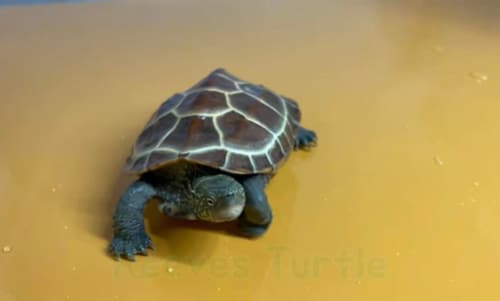
Commonly known as the Chinese pond turtle, the Reeve’s turtle is the only Asian turtle on this list, inhabiting lakes, ponds, and small streams of the countries listed below.
Reeve’s turtles also have an omnivorous diet consisting of fish, worms, insects, green leafy vegetables, as well as aquatic plants.
- Size: 4.5-to-9 inches, males rarely exceed 6 inches
- Lifespan: 10-to-20 years, average of 15 years, oldest ever recorded was 24 years old
- Range: Central and eastern China, North and South Korea, Taiwan, and Japan
Diamondback Terrapin
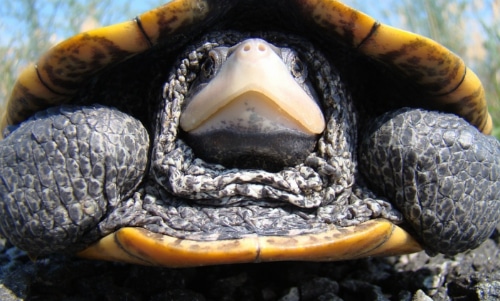
Another one of the smallest aquatic turtles in the world, diamondback terrapins inhabit brackish water systems of salt marshes, as well as estuaries and tidal creeks, feeding mainly on fish, snails, crabs, mollusks, carrion, clams, and worms.
- Size: 4.5-to-9.5 inches, males rarely exceed 5.5 inches
- Lifespan: 25-to-40 years
- Range: Atlantic and Gulf coasts of United States as far north as Massachusetts, as far west as Texas, and as far south as the Florida Keys
Kemp Ridley’s Sea Turtle

Though these aren’t even close to the smallest aquatic turtles out there, Kemp Ridley’s sea turtles are in fact the smallest sea turtles in the world, measuring just over two feet in length at full maturity and weighing an average of 75-to-100 lbs.
For comparison, green sea turtles will often times exceed four feet in length and weigh over 400 lbs. Then we have leatherbacks, the biggest sea turtles in the world, which measure up to 7 feet in length and weigh upwards of 2,000 lbs, though the largest ever recorded was nearly 10 feet long.
Kemp Ridley’s sea turtles, aside from the aforementioned diamondback terrapin, is the only turtle on this list that strictly inhabits saltwater.
Kemp Ridley’s sea turtles feed on crabs, shrimp, snails, clams, jellyfish, sea stars, and a variety of fish.
- Size: 27-to-32 inches
- Lifespan: 30-to-50 years
- Range: Gulf of Mexico, eastern North Atlantic and as far north as Nova Scotia
Speckled Padloper Tortoise
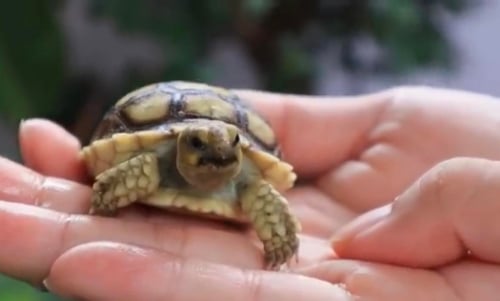
So we got all of the smallest aquatic turtles in the world out of the way, now let’s take a look at the smallest land turtle, or more appropriately titled, the smallest tortoise in the world.
Also known as the speckled dwarf tortoise or speckled cape tortoise, these tiny reptiles inhabit a small arid region in the west of South Africa called Little Namaqualand, ranging the rocky outcrops of this area where they forage along the rocks.
These tiny tortoises are entirely herbivorous, the only herbivores on this list in fact, feeding on leaves, succulents, flowers, grasses, stems, and shrubs.
- Size: 2.4-to-3.1 inches male, up to 3.9 inches female
- Lifespan: 80-to-150 years
- Range: South Africa
If you enjoyed this piece, feel free to share it on social media!

I started writing in the fourth quarter of 2018. I wrote solely about MMA and boxing up until October of 2022, where I began writing about animals; primarily dangerous, venomous species. They’ve always fascinated me. Considering, my goal is to make a living by teaching people about these wonderful creatures. You can check out my Facebook page, where every article I’ve ever written currently sits, or you can check out my Twitter page, where I’ve shared all of my animal pieces to date.

